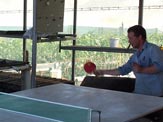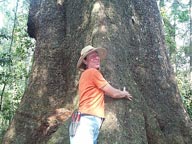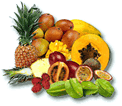August 2002
The Daley News
Featuring:
What's New
The Nursery
The Orchard
Fruit Tree of the Month
Rainforest, Dryland Native and Hedge Plants
Feature article
What's New
Like all Nursery people winter allows us to take a breath and spend some time visiting fellow nurserymen, industry seminars and our valued suppliers. These suppliers are often to thank for some of the new and excellent varieties that will become available in the near future. We have some very exciting and unusual varieties on the way.
A highlight of this month was a visit from Andrew and Fiona Boylan from Incredible Edibles in New Zealand. Also Wayne and Greg visited the State Conference held in Tweed Heads. This is a meeting place for people in the industry and a source of information on the latest developments in Horticulture.
Donna had the pleasure of visiting the Mt Cootha Open Garden in Brisbane and had a great time on the Matthew Flinders walk (see article on Flindersia's) and the bush walk tour. Phil from Nimbin conducted the tour and was a walking encyclopedia in preparing bush foods. Very inspirational so look forward to future newsletter articles on preparing bushfood. If you get the opportunity, jump at the chance to try native honey eaten straight off a lomandra leaf - delicious.
The Nursery
As during all winters previously the plants take less of our time so we can put all that  extra time and effort into building. Well, the Daley twins put the time and effort in but the rest of us give lots of support and very loud applause upon completion of the project. This winter it was the building of an impressive brand new dispatch shed. Our plant carriers love us now as all they need to do is back up the truck in and we wheel the plants on. More importantly though (well important for staff fitness) was the incorporation of an open-air kitchen and table tennis area. If you're ever up our way on a Friday afternoon and fancy your chances in a pingpong tournament you are most welcome. But be warned, we are well practiced.
extra time and effort into building. Well, the Daley twins put the time and effort in but the rest of us give lots of support and very loud applause upon completion of the project. This winter it was the building of an impressive brand new dispatch shed. Our plant carriers love us now as all they need to do is back up the truck in and we wheel the plants on. More importantly though (well important for staff fitness) was the incorporation of an open-air kitchen and table tennis area. If you're ever up our way on a Friday afternoon and fancy your chances in a pingpong tournament you are most welcome. But be warned, we are well practiced.
The Orchard
Greg's tip for the month - This is the time of the year, leading into spring, where its very important to water, mulch, prune and fertilise. Even if you don't have time to do anything else for the year please make time to do this. It has so many benefits, all of which are covered in our free catalogue and various articles throughout the site.
This month is definitely citrus month with the branches of the mandarin and orange trees weighed down with an abundance of nutritious fruit. We are also busy harvesting avocadoes, grapefruit and custard apples.
Fruit Tree of the Month
Grumichama
 If you are in search of a magnificent ornamental tree, one that doesn't grow too tall, offers an abundance of fruit and is relatively maintenance free than take a close look at the Grumichama.
If you are in search of a magnificent ornamental tree, one that doesn't grow too tall, offers an abundance of fruit and is relatively maintenance free than take a close look at the Grumichama.
It originated from Brazil and is a small tree to shrub (4m) with a dense foliage habit. The large leathery leaves (12.5cm) are a rich dark-green colour and are extremely glossy. With a minimum of care these trees always look very healthy and the reddish-bronze new growth is an added feature. They tolerate a large range of soil types, but do well in a slight acid soil, and are generally tolerant of low temperatures and shady conditions. They will also tolerate a light salt spray if you live near the coast. From my experience I have had very few pest problems and have seen no signs of disease. And, because there is such an abundance of fruit there is always plenty for the orchardist and the birds.
With rich soil and adequate water Grumichamas would make an excellent screen plant or a tall hedging plant. They grow more quickly than the jaboticaba at about 60cm per year, and fruit much earlier. I've seen them used as an avenue planting and they looked spectacular.
The pretty white flowers appear in masses and look similar to the other shrubs in the Myrtaceae family. Like the jaboticaba the tree will attract birds and bees when flowering. Seedling trees begin to bear from 4 to 5 years.
About four weeks from flowering (around February to April) the dark purple fruits will appear. The fruits are round, up to 2.5 cm (if adequately watered) and have long stems. The thin skin is dark-purple to black with a light coloured pulp. The soft pulp has a very tasty sweet cherry flavour, hence its nickname of the subtropical cherry, and is eaten fresh or said to make an excellent jelly. We are yet to see the jelly as very few of these fruit are left over. They are always consumed with excitement. Keep in mind when harvesting that the fruits are soft and can be easily damaged which although they are absolutely delicious is why you don't often see them in produce stores.
For something different and more unusual we also have a Yellow Grumichama. This tree is almost impossible to identify from the black grumichama, the only difference being the colour of the fruit.
The grumichama also makes an excellent container plant.
Rainforest, Dryland Native and Hedge Plants
Flindersia species and their virtues ( Matthew's Flindersia's)
 Whether you are an avid ballroom dancer, a nature craftsperson, a rainforest enthusiast, wildlife lover or an avid gardener the Flindersia's have a lot to offer. Commemorating Captain Matthew Flinders the Crow's Ash or Australian Teak (Flindersia australis), Queensland Maple (Flindersia brayleyana), Bumpy Ash (Flindersia schottiana) and the Yellow Wood (Flindersia xanthoxyla) are some of the most popular (dry) rainforest trees from the recorded 21 species in this genus.
Whether you are an avid ballroom dancer, a nature craftsperson, a rainforest enthusiast, wildlife lover or an avid gardener the Flindersia's have a lot to offer. Commemorating Captain Matthew Flinders the Crow's Ash or Australian Teak (Flindersia australis), Queensland Maple (Flindersia brayleyana), Bumpy Ash (Flindersia schottiana) and the Yellow Wood (Flindersia xanthoxyla) are some of the most popular (dry) rainforest trees from the recorded 21 species in this genus.
This Teak in the photo is a very old giant of a tree, measuring 9 metres around. To be there in its presence is awesome. This tree is on a private land holding not far from the nursery.
Durable Cabinet Timber
The Australian Teak is highly respected for its fine timber, (hence the interest to the ballroom dancer, many of whom have waltzed over an attractive and extremely durable teak floor) but all exhibit fine cabinet making qualities.
The Perfect Urban Tree
These are large trees, up to 40m tall, with wide dense canopies. Many of them are lower and more spreading when cultivated as single garden specimens, particularly in the cooler southern climates, however the teak retains its tall forest habit and is usually considered too large for the average garden. In the constant search for the perfect urban tree the team at the Waite Arboretum in SA is trialing both the teak and yellow wood as substitutes for existing plane trees. As Australian natives both are sustained by rainfall and do not shed as many leaves.
Flowers and pods
The flowers of the teak, Queensland maple and bumpy ash are creamy white and produced in large fragrant sprays from August to February with the yellowwood differing by producing clusters of yellow flowers. All are followed by hard brown woody pods that take on a starfish shape and have short blunt prickles. They remain united at the base, but open to expose four, five or six valves that contain flat winged seeds. It is these pods that are used for interior decoration, floral arrangements and nature craft.
Leaves
The attractive leaves are arranged in opposite pairs, with a single leaflet at the tip. They are dark green, paler underneath with numerous transparent dots which can be seen when held to the light and aromatic when crushed.
Wildlife Attracting
As a wildlife attractant the Flindersia's attract orchid butterflies, bees, wasps, moths, honeyeaters and fruit and blossom bats. High branches provide nesting and resting sites for birds.
Feature article - Edible Hedging
Edible Hedges
 As many of you will know, if you contact us asking for a hedge plant we're not going to be pouring out the virtues of the extra common, most accepted popular hedge plants. We're going to shout about the benefits of edible species and how they make great hedges.
As many of you will know, if you contact us asking for a hedge plant we're not going to be pouring out the virtues of the extra common, most accepted popular hedge plants. We're going to shout about the benefits of edible species and how they make great hedges.
Hedges are great. They offer privacy, add class and value to the garden and act as noise barriers - so why not produce a regular harvest from them as well.
You don't have to place them against a fence or on your property perimeter. They are great used to surround kitchen or herb gardens, used as dividers or for creating a 'garden room'.
There are heaps of suitable fruit trees for this purpose.
Citrus trees (Citrus sp) have beautiful dark green glossy foliage, deliciously scented flowers and they bear for long periods. Why not plant them as a living border?
The feijoa (Feijoa sellowiana) is regarded as an ornamental fruit bearing tree or small shrub. Apart from an attractive dull green oval leaf they have spectacular flowers. The pets are a gorgeous rich pink and when eaten or added to drinks and salads they taste sweet like honey.
The strawberry guava (Psidium sp) has glossy evergreen foliage with attractice broze growth. Like the feijoas the flowers are very eye catching.
Bay trees (Laurus nobilus) make a wonderful thick hedge although they take along time to reach their full potential. Bay trees are often seen as topiary and in English kitchen gardens.
A tea (Camellia sinensis) or coffee (Coffee Arabica) hedge
Not many people associate the Camellia sinensis with the flowering camellia. Its flowers may not be as big as the are camellias but are just as beautiful and this plant has provided us with tea leaves for thousands of years. Tea is traditionally hedged to make harvesting easier. Harvesting can start as early as three years.
Life tea, coffee makes a striking hedge. It has large, dark green glossy leaves and requires little care to keep a healthy appearance. The white flowers are followed by stunning dark red berries. Its at this stage that you harvest the coffee beans which are then extracted from the pulpy fruit, dried and roasted. Be warned home processed coffee is for the most avid coffee lovers. It will certainly give your day a boost.
Jaboticaba (Myrciara caufiflora)
 We have given this little tree a good wrap many times and why wouldn't we? It's so versatile. It makes a stunning hedge, a great specimen plant, potted plant or orchard tree. You will know when its flowering as the delightful perfume is very strong and there will be a loud buzzing of over excited bees. The flowers and then fruit are borne on the trunk giving the appearance of being covered in white cotton wool. The round black fruit that follows occurs in abundance and there is plenty for the family as large birds find it more difficult to penetrate the thick foliage.
We have given this little tree a good wrap many times and why wouldn't we? It's so versatile. It makes a stunning hedge, a great specimen plant, potted plant or orchard tree. You will know when its flowering as the delightful perfume is very strong and there will be a loud buzzing of over excited bees. The flowers and then fruit are borne on the trunk giving the appearance of being covered in white cotton wool. The round black fruit that follows occurs in abundance and there is plenty for the family as large birds find it more difficult to penetrate the thick foliage.
To create a hedge quickly plant any of the above 1m apart, provide plenty of mulch, organic matter and adequate water. That's it, how many solely ornamental hedges can offer you this many rewards.
The Cadagi tree (Corymbia torreliana)
As environmentally aware and responsible Nurserymen there are many previously popular trees that we don't sell. The Cadagi is one of these trees and with spring around the corner I know to expect many enquiries about these trees. We are not alone in our decision with many councils along the east coast listing the species as an undesirable noxious weed.
Yes, I know they're a very fast growing shade tree, I know they're the hardiest in your paddock and I know it was one of the most extensively planted shade trees in South East Queensland. Unfortunately though, humans weren't the only forms of wildlife to go crazy for these trees. Our native bees also found them irresistible and this is where the problem lies.
To Bee or not to Bee
After pollination, the seedpods of the Cadagi develop and begin to open in early January and continue to mature until the end of February. This is a serious period of time for native bees. The bees collect the resin that spills from the seeds and mix it with their own native bee wax to be used as nest building and sealing material.
The bees become obsessed with the collection of resin but the problem lies with the resin being attached to the seed, translating to thousands of seeds being carried home by the bees. The determined little bee can be seen carrying two seeds home on their back legs which is an extraordinary feat considering each seed is approximately 1½ millimeters in diameter.
So with this process we have created 3 major problems.
Firstly a Clogged Front Door
There are literally thousands of seeds carried home. The inside for the box is lined with multiple layers of seeds. At the entrance of the nest, there are so many seeds, that the entrance may become completely clogged. A clogged up entrance may prevent air movement and cause overheating, and possible death of the nest. Obviously the bees cannot get in or out either.
Overheating and Collapse
The multiple layers of seed continue to exude resin that is in such large quantities that the fumes on a hot day may kill the colony.
Obsession with Seeds
From observation, the bees will continue to collect excessive seeds and resin during this traumatic period. Unfortunately they forget to clean up or guard the hive leaving it susceptible to one of its great enemies, the native fly.
And just in case any of us are left wondering how this 'natural' event could occur. The native bees and the Cadagi do not naturally occur together. We have brought the tree to the bees.
If that isn't enough to convince any would be planters keep in mind that the Cadagi is also a pest hosting tree which attracts Monolepta beetles and beware of parking your vehicle under these trees. It can be quite challenging to remove the sooty mould attracted by them also.






